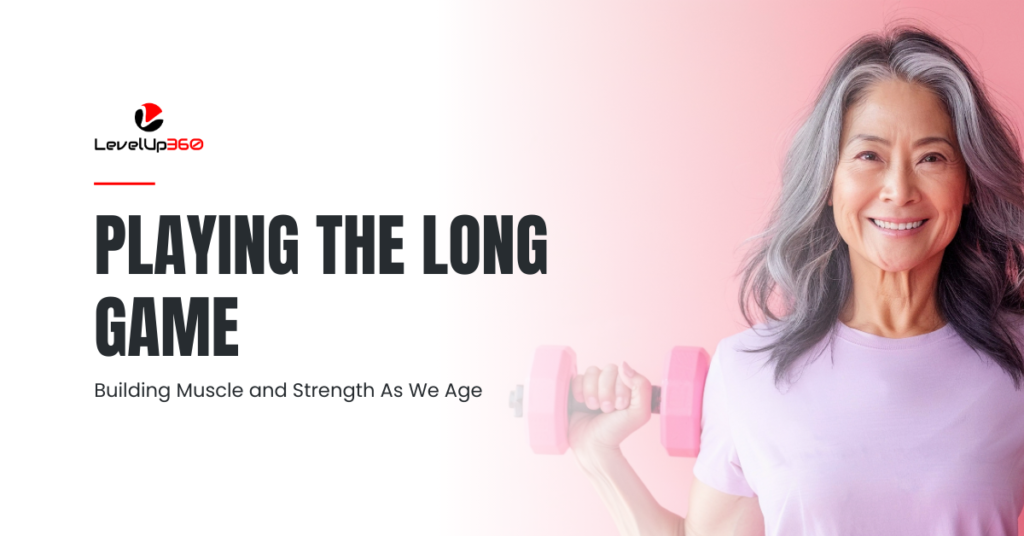
Playing the Long Game: Building Muscle & Strength As We Age
Growing old doesn’t mean growing weak and fragile. While some muscle loss is inevitable as we age, keeping a strong physique well into our later years is achievable through smart training and nutrition. This isn’t about achieving some dramatic body transformation or reaching aesthetic ideals. It’s about maintaining capability, mobility, bone density, and metabolism through that one critical yet often overlooked organ of longevity – muscle.
Think of muscle as a fountain of youth. The more we retain, the more vibrant, energetic and physically able we remain. Who doesn’t want that freedom well into their 60s, 70s and beyond?
Think of muscle as a fountain of youth. The more we retain, the more vibrant, energetic and physically able we remain.
Muscle Growth Expectations – Gains Come Slowly, But Surely
Managing expectations is crucial. Those younger individuals new to training often balloon with muscle rapidly early on as “newbie gains” kick in. But don’t anticipate this rate of return to continue. Like any skill-based endeavour, you improve fastest during the initial learning curve. Early on, strength and muscle gains come quickly as your body adapts to new demands (the older we are the slower it is to build muscle, even as a newbie). But once you’ve overcome the low-hanging fruit, progress slows to a steadier pace.
Does that mean gains stop eventually? Not at all. The window simply extends across more years. Done smartly, you can continue building muscle well into your 50s and 60s. But after the beginner phase, expect incremental progress through consistent effort over long time horizons.
Think of 1% increments in muscle every month or, later on, every few months. That won’t transform your body overnight, but compounded over years results in impressive progress. The key is not dashing off the starting blocks, but rather maintaining a sustainable tempo for the long haul.
Think tortoise vs. hare here. The tortoise exemplifies the patience and persistence needed to reap major rewards gradually over decades.
It’s a marathon, not a sprint. Have you ever watched a marathon runner early in a race bolt ahead at an unsustainable pace only to crash miles later? Meanwhile, those who hold a measured pace eventually cruise by them to the finish. Your fitness journey is much the same. Manage your pace, train consistently, nourish yourself optimally, and progress will come.
Master Proper Exercise Technique – Then Build Load
Those new to training often prioritise adding weight or reps quickly over nailing exercise techniques. Don’t make this mistake. Perfecting your form and building mind-muscle connection takes repetition and attention. Master the basics before chasing new heights.
Rushing into lifting heavy loads without a solid foundation risks injury and limits muscle activation. Proper technique intensifies muscle stimulation at lighter loads anyway.
Focus first on feeling your working muscles contract through their full range of motion. Move smoothly without momentum or jerking. Lockdown optimal posture and cadence.
Once your form is flawless, then gradually add weight in small increments based on your capacity and recovery. But don’t sacrifice skill just to lift more. Mastery enables true strength.
Patience pays off here. Build your technical base early on and it will support bigger loads later safely and efficiently.
Progress At Your Body’s Pace – Don’t Force It
Progress hinges greatly on listening to your body and adjusting along the way. Skip the rigid programs and be flexible. Some days you’ll feel energised and ready to attack new records. Others you’ll drag and need to lighten loads. Vary training volume and intensity based on daily energy and recovery.
Schedule easy and hard training cycles. When pushing hard for a few weeks, take a light week to help the body rebound and minimise injury risk. De-loading allows you to rebuild motivation too. After easing up briefly, you’ll feel recharged to intensify training again.
Patience and adaptability are key. Don’t beat your body into submission if it’s not responding well. Simply take a step back to rebuild capacity, then progress again from there.
Think of it like climbing a mountain. You don’t sprint up without breaks. You hike steadily most days but schedule rest to recover when needed before scaling the next summit.
Incorporate Some Variety – Prevent Overuse and Stimulate Growth

Don’t get stuck on the same lifts forever. Rotate new exercises every few months targeting the same muscle groups to spur further adaptation.
Fresh movements maximise muscle stimulation while giving overused joints a break. Mix traditional strength training with metabolic conditioning to build muscular endurance too. Blend heavy lifting days with higher rep sets. Maintain flexibility through mobility work.
Build workouts around multi-joint compound lifts like squats, presses, rows and deadlifts. But sprinkle in isolation moves for smaller muscle groups. Periodically swap new exercises into your program.
Varying your training attacks muscles from all angles, prevents overuse injuries, and keeps you motivated long-term.
Note: Rotating exercises every few mesocycles (i.e. every few months) can be beneficial, but constantly switching exercises achieves the opposite result as mastering an exercise and getting the most out of it takes time. Rotate exercises when hitting plateaus but don’t be that person that jumps from programme to programme every few weeks.
Fuel Yourself For Muscle Growth – Protein Is Key
Exercise signals muscle growth, but nutrition provides the raw materials to support it. Don’t shortchange your diet. Protein tops the list for muscle building.
Aim for 1.5-2.2g of protein per kg of lean body mass daily from high quality sources: lean meat, fish, eggs, dairy and plant proteins like soy. If possible, spread this intake evenly throughout your day.
Carbs help fuel intense training while vegetables, fruits, healthy fats and minimally processed grains provide micronutrients. For optimal recovery, avoid heavily restricting total calories. If seeking fat loss, create only a modest deficit so you retain energy for training while still able to maintain muscle. Severe calorie cuts degrade muscle.
Treat your diet not as a chore but as a ritual of self-care. Discover nourishing foods you enjoy so healthy eating comes naturally.
Embrace Rest – Gains Happen During Recovery
Gaining muscle and strength requires breaking down muscle tissue through training then allowing recovery. Don’t skip rest days. Schedule at least 1-2 full rest days between lifting sessions. On off days, avoid long distance cardio or physically demanding activities so your body can recharge.
Sleep is essential too. Aim for 7-9 hours nightly to promote muscle repair and optimal hormone levels. Manage life stresses diligently since these increase cortisol which can degrade muscle.
Think of training as the stimulus but recovery as the adaptation. Gains occur when the body is at rest, not during your workout. So be sure to prioritise rest.
Consistency Conquers All
Day after day, week after week, the secret sauce is simply showing up and putting in the work. Motivation ebbs and flows, so too will your workouts. But don’t get discouraged.
Progress isn’t always linear. You’ll have setbacks or weeks where you just don’t feel it. Accept off days as part of the process. Showing up when you don’t feel your best actually builds consistency.
Imagine if you studied a foreign language an hour a day for one year versus only studying once a month for a year. Obviously, daily practice ingrains skills far better even if sessions vary in quality.
Your fitness journey is much the same. Small daily efforts compound over months and years where sporadic training does not. Dedicate yourself each day without judging each workout. Consistency rules all.
Enjoy The Process – It’s a Journey, Not a Destination
Don’t live for some magic end goal that will finally make you “good enough” once reached. No such finish line exists. There are only milestones along an endless, enriching path.
Break free of a results-driven mindset. Instead, immerse yourself in the daily process. Find fulfilment in the ritual of training, not just anticipating the next benchmark accomplished.
True progress is not measured in adding weight to a barbell but in the growth of discipline, character, and confidence. Your body transforms gradually as a side effect of the inner journey travelled.
Savour your workouts as moving meditations. Seek activities that energise your soul, not burn calories. Let fitness nourish you physically, mentally and spiritually.
Trust the Process
No 20-minute workout or fad diet ever sculpted an impressive physique. Lasting results require determination, daily effort and decades-long consistency. But the rewards are monumental.
Imagine your future self at 80 years old – still active, mobile, independent and living life to the fullest. You have your decades of smart training and nutrition to thank.
The maturing athlete knows building an exceptional physique doesn’t require extreme measures, just small steps practised relentlessly over time. Patience and persistence rule all.
There will be setbacks and frustrations, but the path progresses ever upward when you commit to the process. Years from now you’ll look back proud of your dedication.
Walk tall. Aging with strength, purpose and capability is your right. Claim it through simple, mindful daily actions. Your body will thank you for it, as will your quality of life.
Recommended reading
Recommended reading
Additional Resources
Feeling in control of your health
If you are interested in improving your health and wellness, check out other resources such as Our Blog, Free Resources and/or join our private Body-Mind Transformation Secrets Community on Facebook, and go on an even deeper dive with me to uncover how to succeed in your health and wellness goals.
You may also be interested in our Sleep Secrets Cheat Sheet. It is a great resource with strategies to fix and optimize your sleep which is crucial to succeeding in your health and wellness goals.
Resources
Pictures








